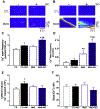Autonomous activation of CaMKII exacerbates diastolic calcium leak during beta-adrenergic stimulation in cardiomyocytes of metabolic syndrome rats
- PMID: 32920522
- PMCID: PMC7530131
- DOI: 10.1016/j.ceca.2020.102267
Autonomous activation of CaMKII exacerbates diastolic calcium leak during beta-adrenergic stimulation in cardiomyocytes of metabolic syndrome rats
Abstract
Autonomous Ca2+/calmodulin-dependent protein kinase II (CaMKII) activation induces abnormal diastolic Ca2+ leak, which leads to triggered arrhythmias in a wide range of cardiovascular diseases, including diabetic cardiomyopathy. In hyperglycemia, Ca2+ handling alterations can be aggravated under stress conditions via the β-adrenergic signaling pathway, which also involves CaMKII activation. However, little is known about intracellular Ca2+ handling disturbances under β-adrenergic stimulation in cardiomyocytes of the prediabetic metabolic syndrome (MetS) model with obesity, and the participation of CaMKII in these alterations. MetS was induced in male Wistar rats by administering 30 % sucrose in drinking water for 16 weeks. Fluo 3-loaded MetS cardiomyocytes exhibited augmented diastolic Ca2+ leak (in the form of spontaneous Ca2+ waves) under basal conditions and that Ca2+ leakage was exacerbated by isoproterenol (ISO, 100 nM). At the molecular level, [3H]-ryanodine binding and basal phosphorylation of cardiac ryanodine receptor (RyR2) at Ser2814, a CaMKII site, were increased in heart homogenates of MetS rats with no changes in RyR2 expression. These alterations were not further augmented by Isoproterenol. SERCA pump activity was augmented 48 % in MetS hearts before β-adrenergic stimuli, which is associated to augmented PLN phosphorylation at T17, a target of CaMKII. In MetS hearts. CaMKII auto-phosphorylation (T287) was increased by 80 %. The augmented diastolic Ca2+ leak was prevented by CaMKII inhibition with AIP. In conclusion, CaMKII autonomous activation in cardiomyocytes of MetS rats with central obesity significantly contributes to abnormal diastolic Ca2+ leak, increasing the propensity for β-adrenergic receptor-driven lethal arrhythmias.
Keywords: Ca(2+)/calmodulin-dependent protein kinase type II; Cardiac ryanodine receptor phosphorylation; Diastolic Ca(2+)leak; High sucrose diet; Metabolic syndrome; β-adrenergic stimulation.
Copyright © 2020 Elsevier Ltd. All rights reserved.
Conflict of interest statement
Competing interests
The authors declare that they have no competing interests.
Figures






References
-
- Alberti KGMM, Eckel RH, Grundy SM, Zimmet PZ, Cleeman JI, Donato KA, Fruchart JC, James WPT, Loria CM, Smith SC, Harmonizing the metabolic syndrome: A joint interim statement of the international diabetes federation task force on epidemiology and prevention; National heart, lung, and blood institute; American heart association; World heart federation; International, Circulation. 120 (2009) 1640–1645. - PubMed
-
- Arellano-Campos O, V Gómez-Velasco D, Bello-Chavolla OY, Cruz-Bautista I, Melgarejo-Hernandez MA, Muñoz-Hernandez L, Guillén LE, Garduño-Garcia J, Alvirde U, Ono-Yoshikawa Y, Choza-Romero R, Sauque-Reyna L, Garay-Sevilla ME, Malacara-Hernandez J, Tusie-Luna MT, Gutierrez-Robledo LM, Gómez-Pérez FJ, Rojas R, Aguilar-Salinas CA, Development and validation of a predictive model for incident type 2 diabetes in middle-aged Mexican adults: the metabolic syndrome cohort, BMC Endocr. Disord 19 (2019) 41. - PMC - PubMed
-
- Grundy SM, Brewer HB, Cleeman JI, Smith SC, Lenfant C, Definition of Metabolic Syndrome: Report of the National Heart, Lung, and Blood Institute/American Heart Association Conference on Scientific Issues Related to Definition, Circulation. 109 (2004) 433–438. - PubMed
-
- Alberti KGMM, Zimmet P, Shaw J, The metabolic syndrome - A new worldwide definition, Lancet. 366 (2005) 1059–1062. - PubMed
Publication types
MeSH terms
Substances
Grants and funding
LinkOut - more resources
Full Text Sources
Medical
Molecular Biology Databases
Miscellaneous

